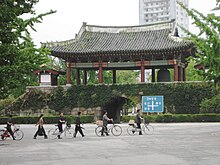Historic Monuments and Sites in Kaesong

Historic Monuments and Sites in Kaesong are a group of archaeological sites in North Korea that show the history of the Koryo Dynasty, which ruled Korea from 918 c.e. to 1392 c.e. All together, they were named a UNESCO World Heritage Site in 2013.[1][2][3]
Kaesong was the capital city of the Kingdom of Koryo. The city's gates, palaces, tombs and monuments, walls, schools, tower for looking at the stars and other buildings all together make up the World Heritage Site because they show the philosophy, culture, politics and spiritual beliefs of the Koryo people. The city's layout shows a mixture of Buddhism, Taoism and Confucianism. It especially shows the change from Buddhism to neo-Confucianism that happened during the Koryo Dynasty.[1]
Walls and gates
[change | change source]UNESCO says three different sections of wall and a few gates in Kaesong have enough historical value to be part of the site. The Palocham Wall was built in 896 c.e., just before the Koryo Dynasty. The Outer Wall was built in 1009-1029 and connected the city to the nearby Songak, Puhung, Tokam, Jine and Ryongsu Mountains. The wall was built to defend the city, but it also shows what people believed about the magic or spiritual power of mountains. The Inner Wall was built in 1391-3, just as the Koryo Dynasty was ending.[1]
The Namdae Gate in the Inner Wall was the main gate on the south side of Kaesong.
Palaces and schools
[change | change source]Manwoldae Palace is now an archaeological site. It was the royal palace for 500 years. It burned down four times and the people rebuilt it over and over. In modern times, North Korean and South Korean teams have worked at the site together to study it.[4]
The ruins of the Kaesong Chomsongdae are also part of the site.. Comsongdae was an observatory where people studied the stars and weather. The Koryo Songgyungwan was a school for government officials and Sungyang Sowon was a school of Confucian philosophy.
Sonjuk Bridge is where the high official Jong Mong Ju was assassinated, an event that was part of the end of the Koryo Dynasty.[1]
Tombs and monuments
[change | change source]
The Heritage Site includes large mausoleums for King Taejo of Goryeo and King Gongmin of Goryeo. It has two other groups of tombs as well, the Seven Tombs Cluster and Myongrung Tombs Cluster. There are also two steles for Jeong Mong-ju, called the Phyochung Monuments. Steles are memorial pillars that may have the dead person's name written on them but do not contain his or her body.[1]
References
[change | change source]- ↑ 1.0 1.1 1.2 1.3 1.4 "Historic Monuments and Sites of Kaesong". UNESCO. Retrieved August 15, 2020.
- ↑ "DPR Korea: UN adds ancient city of Kaesong to its World Heritage list". UN News. June 23, 2013. Retrieved August 15, 2020.
- ↑ Matthew C. Crawford (October 20, 2018). "North Korean holidays may become easier and cheaper. Here are four must-see destinations". South China Morning Post. Retrieved August 15, 2020.
- ↑ "The Manwoldae Palace at Gaeseong". Seoul Museum of History. 2018. Retrieved August 15, 2020.
